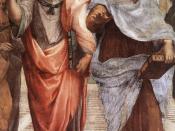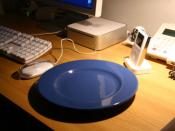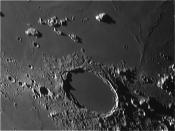The Forms vs. the Cosmos
The world of Forms
1. The world of being; everything in this world "always is," "has no becoming," and "does not change"(28a).
2. It is apprehended by the understanding, not by the senses.
The physical world (= the Cosmos)
1. The world of becoming; everything in this world "comes to be and passes away, but never really is" (28a).
2. It is grasped by opinion and sense-perception.
3. The cosmos itself came into being, created using as its model the world of Forms.
The Demiurge (Creator)
Literally, "craftsman." The creator of Plato's physical world is not a divine intelligence or a personal ruler, but (as it were) a manual laborer. Cf. Vlastos, Plato's Universe (pp. 26-27):
That the supreme god of Plato's cosmos should wear the mask of a manual worker is a triumph of the philosophical imagination over ingrained social prejudice. ... But this divine mechanic is not a drudge.
He is an artist or, more precisely, what an artist would have to be in Plato's conception of art: not the inventor of new form, but the imposer of pre-existing form on as yet formless material.
The Elements
* The physical world must have bodily form; it must be visible and tangible (31b).
* Hence, its ingredients must include fire and earth.
* Since fire and earth will have to be combined, there must be at least one other ingredient that serves to combine them.
* But since fire and earth are solids, we require two intermediates to combine them.
* Hence, the demiurge created air and water, and arranged all four elements proportionally: as fire is to air, air is to water; as air is to water, water is to earth.
* As we will see below, we have not reached the...


